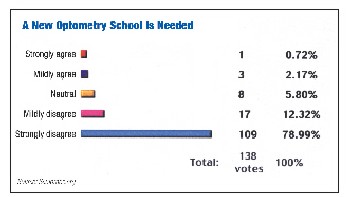The University of North Carolina at Pembroke (UNCP) is trying to open a new optometry school. The General Assembly of the state of North Carolina awarded $10 million to the university to study and plan for an optometry school at its campus in Pembroke, a small rural town in the southern part of the state.
The money is to be used for land acquisition; site preparation; and engineering, architectural and other consulting services, says Glen Burnette, UNCPs vice chancellor for university and community relations.
This came about due to the efforts of state Sen. David Weinstein, a former member of UNCPs board of trustees. The senator has been pushing for an optometry school at UNCP, which is within his district, for at least six years.
But its not a done deal yet. First, the administration at the Pembroke campus must submit its proposal to the office of the president of the University of North Carolina System. If approved, then we will move forward to convince the political leadership and the optometric profession that we can build and operate one of the best, high quality schools of optometry in the United States, says Roger Brown, Ph.D., UNCPs provost and vice chancellor for academic affairs.
If all goes well, the new optometry school would open in the fall of 2007 and graduate its first class of students in the spring of 2011, Dr. Brown says.
But is a new optometry school necessary, or even wanted?
It will have a detrimental effect on the already overwhelming excess of eye care providers we have now, says Tom Miller, O.D., who practices in the nearby town of Fayetteville and who attended UNCP as an undergraduate.
 |
While Dr. Miller doesnt think a new school would affect his established practice, he believes that it could affect the livelihoods of future O.D.s. I think it would be safe to say that very few current optometrists think we need more O.D.s or another school, he says. Simply put, our current supply greatly outweighs our current demand.
UNCPs Dr. Brown disagrees. Even though some [optometrists] believe that the overall numbers of optometrists are adequate, they are over-distributed in the urban areas, he says. But in rural and minority communitiesparticularly in the Souththere arent enough O.D.s, he says.
There is no school of optometry between Philadelphia and Birmingham, or between Miami and Memphis, Dr. Brown points out. He adds that North and South Carolina have fewer O.D.s per capita than the national average and fewer per capita than recommended by the AOA.
We also believe that in the next 20 years, the number of optometrists and the increased demand for eye care will make room for many more eye care professionals, Dr. Brown says.
Whats more, the UNCP school of optometry would have a class size of only 25 students, which would present no threat of over-supplying the market for doctors, he says.
Citing its antitrust policy, the Association of Schools and Colleges of Optometry refrained from comment or taking a position on the potential new school of optometry.
The North Carolina Optometric Society has taken a cautious stance, asking for (and willing to help contribute to) reliable research on the need and use for a new optometry school, says optometrist C.H. Smith, Jr., president of the state association.
We have to have good solid social science involved in this so that we can prove to ourselves and our constituents that this is good for the citizens of North Carolina and also good for North Carolina optometry, Dr. Smith says.
| AMO to Acquire VISX Advanced Medical Optics Inc. (AMO) will acquire VISX Incorporated. The merger will create a $1 billion global ophthalmic company, which will retain the Advanced Medical Optics name. Upon completion of the transaction, AMOs stockholders will own approximately 58.5% of the combined company, and VISXs stockholders will own approximately 41.5%. The merger is a strategic and complementary fit, the companies say. VISX produces laser vision correction systems. AMO produces ophthalmic surgical and contact lens care products, such as foldable intraocular lenses, phacoemulsification systems, viscoelastics and microkeratomes. |

